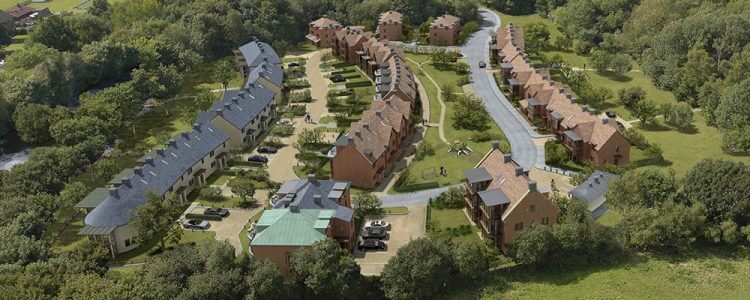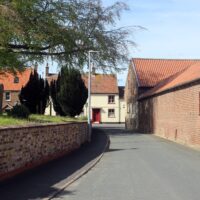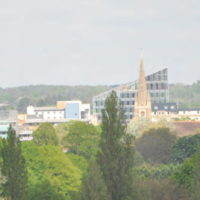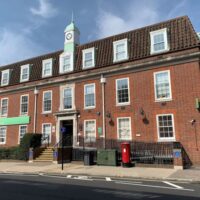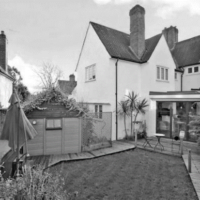Fuller Long have achieved planning permission on behalf of a client for the erection of a four bedroom dwelling on land to the south of Bagshot Road within the Metropolitan Green Belt
The site, extended to 0.27 hectares and formed part of a wider parcel of land in the same ownership. The site was formerly used as part of Chobham nurseries, located on the opposite side of Bagshot Road, for servicing and vehicle parking. An area of hardstanding and a polytunnel, which related to the former use and of the land, remained on site.
In order to aid the granting of permission, Fuller Long undertook a public consultation exercise in the form of a community consultation website. The website was specifically designed to facilitate open communication between local residents and the design team, to allow a community led approach to the design and ultimately achieve a successful application. Fuller Long consulted 221 local residents and businesses and received 12 responses. Of these responses, eight were positive and generally supportive of the proposal, one was neutral and three commented on the design and location of the house, all of which were addressed by Fuller Long.
Though the site was located on Green Belt land, Fuller Long argued that the proposed new dwelling would not have a greater impact upon the openness of the Green Belt than the existing polytunnel and hardstanding. Fuller Long also stated that the existing polytunnel was disused and unattractive. Additionally, the proposed dwelling of a high quality design, would improve and enhance the overall appearance of the site and the wider streetscene.
Fuller Long further argued that if indeed the Council were to object, that very special circumstances also existed, which included, housing need, high quality design and significant environmental improvements. These very special circumstances, thus, outweighed any perceived harm to the openness of the Green Belt.
However, the application received objection from Surrey Wildlife Trust and the Council’s arboricultural officer. In order to overcome this issue, Fuller Long submitted an updated ecological assessment as part of the application and following recommendations, sought a further reptile survey. The ecological report found that there would be no significant change or damage to the nature conservation value of the field as a whole and given the proposed dwelling would be located on previously developed land, there would be no ecological impact. An updated arboricultural report was also submitted as part of the application. This revealed that there were no trees on the application site and the trees located adjacent to the northern and eastern boundary would be protected during construction.
Fuller Long also assured the Council that the proposed dwelling would not cause any adverse amenity impacts. There were no other properties close enough to be affected by the new dwelling and as such. The proposal was thus considered acceptable and compliant with policy DM9. In doing so, Fuller Long were able to obtain permission for development on the site.
Green Belt Land and the Issues Surrounding it
Green Belt land use policy was designated in the 1950s and it has been argued that it is no longer a realistic fit for the current rates of development needed to meet demand in the UK. The modern Green Belt is often not as green as it is portrayed by the media. It has been reported by the Guardian that huge chunks are intensively farmed agricultural land with limited access, chemical pesticides and a total lack of biodiversity. The Guardian further reports that Oxford is so tightly constrained by its green belt, that there is no room to build significant numbers of homes, thus making it one of the least affordable places to live in Britain.
Government statistics show that more than a third of land in England is is protected from development through being part of an Area of Outstanding Natural Beauty, a National Park or part of the Green Belt. However, this designation aimed at preventing urban sprawl, is arguably constricting cities that are in desperate need of expansion and further development.
Though, some argue that the preservation and protection of the Green Belt is an imperative. The Green Belt forms a unique and valuable barrier that prevents the complete urbanisation of land in the UK. The Green Belt is also, despite not being its primary purpose, provides a green space that has important environmental ties.
Debates surrounding Green Belt land will continue to transpire as the urgency for new development increases, whilst the need to protect the Green Belts strengthens. The Green Belt in itself is a contested space, with many debating its use and purpose.
To discuss a Green Belt planning issue with one of our experienced team of consultants, please call us on 0808 164 1288 for a no obligation conversation or email us at hello@fullerlong.com
Sources used:
https://www.theguardian.com/commentisfree/2017/sep/22/green-belt-housing-crisis-planning-policy

